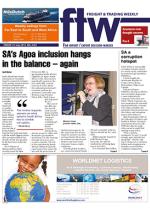Although shipowners are
up in arms about shallower
berths at the Port of Durban
continually cutting into their
vessels’ potential payloads,
the Durban harbour master
says plans are afoot for more
dredger horsepower to tackle
the problem head-on this year.
TNPA this week received
Transnet approval to build
a new grab hopper dredger
dedicated to the port which
should be delivered at the end
of 2016. Until this is delivered
the Port of Durban will lease
an appropriate tool. An
official request for proposal is
due to be issued shortly.
The port, however, must be
gaining a reputation amongst
international seafarers as a bit
of a backwater harbour – with
diminishing berth depths
(draughts) continually getting
worse at the three main piers.
TNPA says it is not
maintenance dredging that is
the issue.
“The dredging services
division has to treat the
symptoms of the problem
of much bigger vessels now
visiting the port and the
resulting ships’ propulsion
and bowthruster effects
displacing material and scour
at the berths. This means
dredging time is doubled
because you now have to
dredge this scour and place
it on the quayside so that it
can be reinstated, as well as
address the damage it causes
to equipment,” said port
manager, Moshe Motlohi.
At the last FTW count
there were six container
berths (105, 107, 108, 200,
204 and 205) all working with
reduced draughts – of 11.7m
in four cases (105, 107, 200
and 204) 11.8m in one (108)
and 11.9m in one (205). This is
compared to all their original
permissible draughts of
12.2m, against a total draught
of 12.8m.
And now, just joining
this lengthening list of
Transnet National Ports
Authority (TNPA) berths with
diminishing draughts are:
Maydon Wharf Berths 10 and
11 and BCA 4.
The reason, said an FTW
commentator, was: “Because
they’re only dredging at
107, 108 (Pier 1 container
terminal) and widening the
harbour.”
MW10 drops from a
permissible draught of 9 to
8.5m. MW 11 drops from 10m
to 9.7m. BCA 4, meantime,
drops from 10m to 9.6m.
Surveys show the Impisi
plough tug was effective at
MW 9 but TNPA was unable
to complete dredging work
during the short 1.5 days
occupation it was allowed.
TNPA’s Dredging Services
division says it has also been
prohibited from dredging
BCA because of contaminated
coal found there. Motlohi says
high spots are coal deposits
and TNPA does not have the
authority to dredge or dump
coal in the dump site.
This is costing the shipping
lines rather a large amount of
moolah as they have to sail in
up on their marks. And the
more of the Plimsoll line that
is showing, the less the vessel’s
payload.
On the container side, one
shipowner’s agent worked out
that, as a very approximate
average, this would be
costing around 1 000 TEUs
per voyage (500 boxes off,
500 on). And, for the bulk
or breakbulk vessels using
Maydon Wharf, another line
executive thumbsucked “about
20-25 000 tonnes” lost for a
vessel lightloaded.
And, as Peter Besnard,
CEO of the SA Association of
Ship Operators and Agents
(Saasoa) told FTW earlier
this year, shallower berths
have meant that limitations
have had to
be imposed,
bringing about
a marked
drop in vessel
liftings and
throughput
through
the Port of
Durban.
According to
Besnard, this
is a worrying
trend that is
sure to drive
up the cost of
doing business.
But,
Besnard told FTW, at a
meeting last week the Durban
harbour master, Captain Alex
Miya, convinced the Saasoa
members in attendance that
he was extremely aware of the
problems.
And, talking to FTW after
this meeting, Miya said that
dredging services should
see some relief through
the leased dredger and
the dedicated grab hopper
dredger expected next year.
Another big step up in
dredging power is due in
December when TNPA’s new
suction dredger (“A big one,”
said Miya) is due to arrive in
SA. While the new Ilembe
will not be used to dredge
the DCT berths, it will help
address larger areas such as
the entrance channels more
effectively.
And the problem, Miya
said, is mostly a result of
larger ships now using the
harbour. The additional
scouring of the harbour
bottom by these larger ships’
props – building up sand and
rocks alongside the berths
– is going
to require a
new dredging
programme,
he told FTW.
“We’ll have
to increase
our frequency
even more.
We used to
do it every
3-6 months.
Under these
conditions,
berths
requiring
dredging
every 3-6
months now need dredging
every week or 2.”
Meantime, TNPA is
sending out a weekly dredging
update to stakeholders.
INSERT & CAPTION
Limitations have
had to be imposed,
bringing about a
marked drop in
vessel liftings and
throughput through
the Port of Durban.
– Peter Besnard
CAPTION
The Port of Durban... diminishing draughts at some berths.

